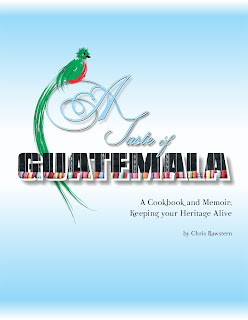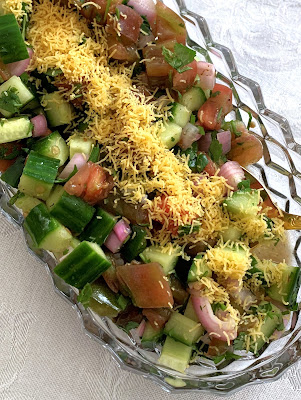In my spare time, which there is a lot of these days, I make books. Not to sell, though many have suggested it. For my own reference, I created a "My Favorite Recipes" book a long time ago, going on to create a Volume II as there were so many more recipes that came to mind after finishing the first volume.
I have made books of bird and fowl identification, using photos I had taken or from my sisters for identifying purposes, spend a lot of online time researching descriptors and other details so If I came home with yet another unidentified photo, I had a resource for identification. I made a book of all the flowers, be they weeds, wild or other, from trips to the Pacific northwest, one from flora of California I had photographed, of orchids I'd grown myself or taken photos of in botanical gardens. More recently, I created 4 smaller books of plants and flowers on Arizona (one of cacti, one of tender plants, one of succulent type plants and one of shrubs and trees). 
My Guatemalan Cookbook
Many other cookbooks have been made since those first ones so long ago. One was a memoir cookbook of Guatemalan recipes for my oldest daughter when she turned 40. I had lived in Guatemala for 12 years, and my children were born there. My oldest was still closest to the relatives there; still spoke Spanish reasonably well. At the time of creating that book, I had made such few recipes as were included in the book, maybe around 40, because there was nothing online to find nearly 12 years ago. Since then I have added to that memoir cookbook for my son and next daughter turning 40. I have managed to include over 80 recipes in there now, and I learn more as the years go by.
 |
| My Bread Cookbook |
Idli was something I got interested in - as a concept - a LOT of years ago, but never got around to trying, out of fear. Too many conflicting admonitions, a lot of strictures, and it was just so foreign (excuse the word) a concept. So I managed to set that on the back burner for about 8 years. Once I did venture to make Idli, while the batter did not ferment (remedied by adding baking soda last minute before using), I loved those little steamed pillows! But making Idli is a definite process, needing time and some attention. When I read about Utappam, I really wanted to try, but did not want to go through all that trouble of making Idli batter just then.
I mused on that a bit and thought,
"Really, idli batter is made of presoaked rice and urad dal, with a little fenugreek and a little cooked leftover rice or Poha rice, then grinding the soaked grains to a batter. What it I skipped the first part of soaking the rice and the lentils and used rice flour and pre-ground urad dal? I have fenugreek powder. Poha rice nearly disintegrates in liquid anyway."
I proceeded to try that out, but as a quick version used instant yeast to approximate fermentation (it took a couple of hours to rise). It was good, and it worked. Still, obviously the fermentation process would be adding proper flavor. These yeasted ones, while good, were curiously "flat" tasting. So I went back and made a new batter. After mixing the ingredients I left it on the counter for nearly 24 hours, at which time I saw a slight growth of the batter and some bubbles. Eureka!
 |
| Clockwise from top left: Nariyal chutney, Idli Podi, Idli, and Imli Chutney |
This batter made lovely and very delicious Utappam, as well as Idli, so I am truly happy.
Quicker Idli or Utappam Batter
 |
| Utappam |
1 cup white rice, ground finely to equal 1 1/4 cups, OR use 1 1/4 cups preground rice flour flour (about 190 grams)
1 teaspoon fenugreek seeds (3 grams), ground finely, OR 1 1/4 teaspoon fenugreek in powder form
1/3 cup peeled split urad dal, ground to flour (about 74 grams), or 3/4 cup once ground (- not a typo!)
1/4 cup Poha rice,
OR use 1/4 cup leftover cooked rice
3/4 teaspoon salt
1 3/4 cups cool water, or as needed
Place the rice flour, urad dal flour, ground fenugreek and Poha rice into a large mixing bowl. Begin stirring in the water with a wooden spoon, so as not to form lumps. Add only enough water to make what looks like a stiff pancake batter. Set the bowl aside in a warm area and cover with a lid or plastic film and allow to ferment. This may take up to 24 hours. Look for puffing, bubbles and a nice fermented aroma. Once ready to use, stir in the salt.
To make Utappam, heat a skillet as you would for pancakes. Lightly grease the pan and ladle in batter, as for pancakes, spreading to about 5 or 6-inches in diameter. While the "pancake" is cooking on one side, place your desired toppings on the uncooked upper side. Possible toppings include:
cilantro,Idli Batter in tray to steam
- parsley,
- curry leaves,
- shredded fresh ginger,
- sliced onion or shallot,
- chopped garlic,
- grated carrot,
- chopped bell pepper (green or red),
- chopped or sliced green chilies (Serrano or Jalapeno are good),
- chopped tomatoes (not too juicy),
or anything else that sounds good. (Limit the toppings as they will only fall off if too many are in place when the pancake is flipped over.) Once the bottom is browned, drizzle some oil over the toppings before turning and then flip the pancake to lightly brown the other side. Serve with toppings upwards, with any chutney or pickle of choice, with a dal dish or a soup.
To make Idli, a traditional south Indian breakfast or snack food, an Idli stand is a must. My Idli stands consist of a three-tiered stand with a base to be able to set into a large pot with a shallow layer of lightly boiling water. The little rounded wells, 4 per tray (with three trays total), are filled just to their edges and stacked. Once set into the pot with water, the water must not touch the bottom tray. Cover the pot and steam the idli for about 7 to 9 minutes. They should test done as for a bread or cake, by inserting a toothpick in center that should come out clean. Idli can be served with any curry or leftovers, with Sambar, Tamatar ki Chatni, Tamarind (Imli) Chutney, Coconut (Nariyal) Chutney, Idli Podi (a dry spiced mixture that tastes heavenly), or all by themselves with any of these chutnies or Podi.
My passion is teaching people how to create a harmony of flavors with their cooking, and passing along my love and joy of food, both simple or exotic, plain or fancy. I continue my journey in ethnic and domestic cuisines, continuing my journey to explore diverse culinary experiences and hopefully to start you on a journey of your own. Join me also at A Harmony of Flavors on Facebook, and Pinterest.




